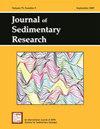Cyclicity of Katatectic Layers within Anhydrite Caprocks, U.S. Gulf Coastal Region
IF 2
4区 地球科学
Q1 GEOLOGY
引用次数: 0
Abstract
An anhydrite caprock overlies 65% of the 329 onshore salt stocks of the U.S. Gulf Coastal Region, South-Central U.S. The caprock consists of a succession of katatectic (downward-building) layers of anhydrite (each typically 1 to 4 cm thick) and an upper, black pyrite lamina (approx. 0.1 mm thick). The older (upper) katatectic layers are usually highly deformed. During four stages, these fundamental layers formed at the crest of shallow (less than 1,200 m) salt stocks. Repetition of sets of the stages resulted in the cyclicity. The closed stage: A flush, nearly planar contact separated mature anhydrite caprock from an underlying salt-stock crest. As the diapir elevated by a few mm/yr, it arched the caprock; it also opened conduits at the stock’s uppermost anhydrite sheath, allowing NaCl-undersaturated water from outside the diapir to contact the salt stock. The open-dynamic stage: Along the perimeter of the uppermost salt stock, a narrow, annular halite cave advanced inward and upward directly below the slightly convex base of the anhydrite caprock. The most NaCl-aggressive water rose by free convection to the highest elevations and dissolved halite. The dense, solute-enhanced water then reversed direction and, again, by free convection, flowed past the stock’s margin into country rock; NaCl-undersaturated water replaced the departing brine. A water-filled, commonly ring-shaped, planar cave up to several meters high expanded over the stock’s crest. Sparse physical supports, buoyancy, arched caprock, and high artesian water pressure prevented the cave’s collapse. The cave’s halite floor dissolved vertically downward faster than it moved diapirically upward. As the crestal halite dissolved, a small amount of residual pyrite and, typically, a layer up to approx. 10 cm thick of residual anhydrite (generally 3-8 wt % of the stocks) accumulated on the cave floor. The open-static stage: The persistent “attack” of halite highs by the NaCl-undersaturated water eventually caused the slope of the cave’s floor to approach horizontality. The density-driven flow slowed markedly, and a static cover of NaCl-saturated brine thwarted the dissolution of the halite floor. The downward movement of the cave’s floor reversed, and it moved slowly upward via diapirism. Concurrently, an anhydrite sheath evolved around the uppermost stock. The accretionary stage: The cave closed within a few thousand years, and active diapirism underplated the admixed residual minerals onto the base of the caprock. The uppermost, now compact, residual anhydrite dissolved within the high-pressure environment, leaving the discrete, topmost, thin, black pyrite lamina. With the accretion of the residual minerals, a katatectic layer formed at the base of a succession of such layers. The closed stage recurred, and a new katatectic cycle began forming. Variations of the four genetic stages probably occurred during the formation of anhydrite caprocks in other worldwide salt dome provinces, but because of insufficient data, they are usually unrecognizable.美国海湾沿岸地区无水岩毛岩中片状层的周期性
美国中南部海湾沿岸地区的 329 个陆上盐类储量中有 65% 覆盖着无水硬石膏盖层。较早的(上部)卡特石层通常高度变形。在四个阶段中,这些基本层形成于浅(小于 1,200 米)盐丘的顶峰。各阶段的重复形成了周期性。封闭阶段:一个平齐的、近乎平面的接触面将成熟的无水石膏毛岩与下层盐层顶峰隔开。当斜坡以几毫米/年的速度上升时,它拱起了毛岩;同时也在盐层最上层的无水石膏鞘处打开了通道,使斜坡外的 NaCl 不饱和水能够接触到盐层。开放动力阶段:沿着最上层盐层的周边,在无水石膏盖岩微凸基底的正下方,一个狭窄的环状海绿石洞穴向内向上推进。NaCl侵蚀性最强的水通过自由对流上升到最高处,溶解了海绿石。然后,浓密的溶质强化水逆转方向,再次通过自由对流,流过矿床边缘,进入乡间岩石;NaCl 不饱和水取代了离开的盐水。一个充满水、通常呈环形、高达数米的平面洞穴在岩浆顶上扩展开来。稀疏的物理支撑、浮力、拱形盖岩和高自流水压力阻止了洞穴的坍塌。洞穴底部的海绿石垂直向下溶解的速度快于其斜面向上移动的速度。随着嵴状海绿石的溶解,少量残余黄铁矿和一般情况下厚达约 10 厘米的残余无水石膏层(一般占存量的 3-8 重量%)在洞穴底部堆积起来。开放静止阶段:NaCl 不饱和水对海绿石高地的持续 "攻击 "最终导致洞穴底部的坡度接近水平。密度驱动的水流明显减缓,NaCl饱和盐水的静态覆盖阻碍了海绿石底部的溶解。洞穴底部的向下运动发生了逆转,并通过陡斜作用缓慢向上移动。与此同时,最上层岩浆周围形成了一个无水岩护套。增生阶段:洞穴在几千年内关闭,活跃的透射作用将混合的残余矿物下沉到盖层岩的底部。最上层的残留无水石膏在高压环境中溶解,留下了离散的、最上层的黑色黄铁矿薄层。随着残留矿物的增生,在一连串此类岩层的底部形成了卡特石层。封闭阶段再次出现,一个新的卡塔特里周期开始形成。这四个遗传阶段的变化很可能发生在世界其他盐穹矿带的无水石膏毛岩形成过程中,但由于数据不足,通常无法识别。
本文章由计算机程序翻译,如有差异,请以英文原文为准。
求助全文
约1分钟内获得全文
求助全文
来源期刊
CiteScore
3.80
自引率
5.00%
发文量
50
审稿时长
3 months
期刊介绍:
The journal is broad and international in scope and welcomes contributions that further the fundamental understanding of sedimentary processes, the origin of sedimentary deposits, the workings of sedimentary systems, and the records of earth history contained within sedimentary rocks.
文献相关原料
| 公司名称 | 产品信息 | 采购帮参考价格 |
|---|

 求助内容:
求助内容: 应助结果提醒方式:
应助结果提醒方式:


